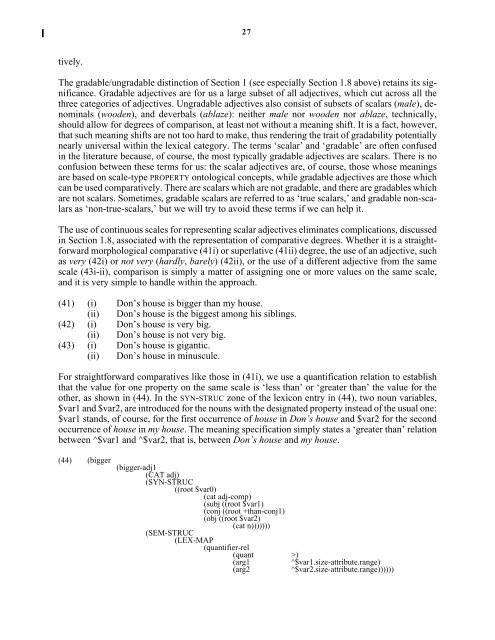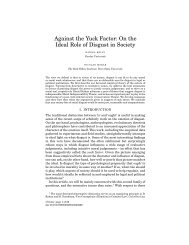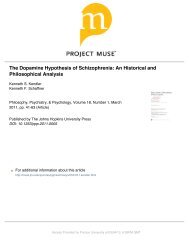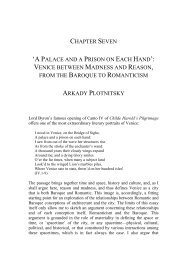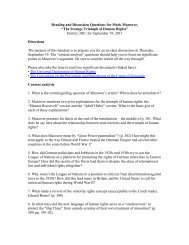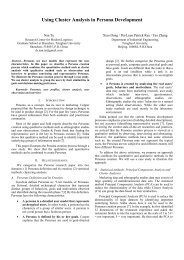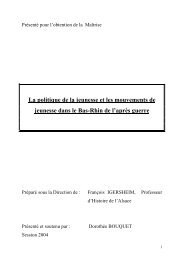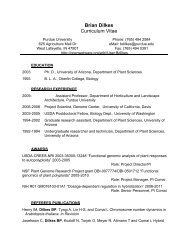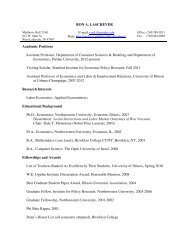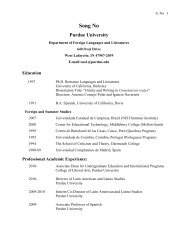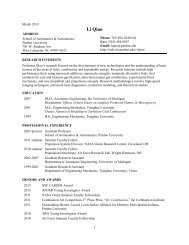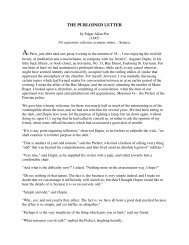Lexical Semantics of Adjectives - CiteSeerX
Lexical Semantics of Adjectives - CiteSeerX
Lexical Semantics of Adjectives - CiteSeerX
Create successful ePaper yourself
Turn your PDF publications into a flip-book with our unique Google optimized e-Paper software.
tively.<br />
27<br />
The gradable/ungradable distinction <strong>of</strong> Section 1 (see especially Section 1.8 above) retains its significance.<br />
Gradable adjectives are for us a large subset <strong>of</strong> all adjectives, which cut across all the<br />
three categories <strong>of</strong> adjectives. Ungradable adjectives also consist <strong>of</strong> subsets <strong>of</strong> scalars (male), denominals<br />
(wooden), and deverbals (ablaze): neither male nor wooden nor ablaze, technically,<br />
should allow for degrees <strong>of</strong> comparison, at least not without a meaning shift. It is a fact, however,<br />
that such meaning shifts are not too hard to make, thus rendering the trait <strong>of</strong> gradability potentially<br />
nearly universal within the lexical category. The terms ‘scalar’ and ‘gradable’ are <strong>of</strong>ten confused<br />
in the literature because, <strong>of</strong> course, the most typically gradable adjectives are scalars. There is no<br />
confusion between these terms for us: the scalar adjectives are, <strong>of</strong> course, those whose meanings<br />
are based on scale-type PROPERTY ontological concepts, while gradable adjectives are those which<br />
can be used comparatively. There are scalars which are not gradable, and there are gradables which<br />
are not scalars. Sometimes, gradable scalars are referred to as ‘true scalars,’ and gradable non-scalars<br />
as ‘non-true-scalars,’ but we will try to avoid these terms if we can help it.<br />
The use <strong>of</strong> continuous scales for representing scalar adjectives eliminates complications, discussed<br />
in Section 1.8, associated with the representation <strong>of</strong> comparative degrees. Whether it is a straightforward<br />
morphological comparative (41i) or superlative (41ii) degree, the use <strong>of</strong> an adjective, such<br />
as very (42i) or not very (hardly, barely) (42ii), or the use <strong>of</strong> a different adjective from the same<br />
scale (43i-ii), comparison is simply a matter <strong>of</strong> assigning one or more values on the same scale,<br />
and it is very simple to handle within the approach.<br />
(41) (i) Don’s house is bigger than my house.<br />
(ii) Don’s house is the biggest among his siblings.<br />
(42) (i) Don’s house is very big.<br />
(ii) Don’s house is not very big.<br />
(43) (i) Don’s house is gigantic.<br />
(ii) Don’s house in minuscule.<br />
For straightforward comparatives like those in (41i), we use a quantification relation to establish<br />
that the value for one property on the same scale is ‘less than’ or ‘greater than’ the value for the<br />
other, as shown in (44). In the SYN-STRUC zone <strong>of</strong> the lexicon entry in (44), two noun variables,<br />
$var1 and $var2, are introduced for the nouns with the designated property instead <strong>of</strong> the usual one:<br />
$var1 stands, <strong>of</strong> course, for the first occurrence <strong>of</strong> house in Don’s house and $var2 for the second<br />
occurrence <strong>of</strong> house in my house. The meaning specification simply states a ‘greater than’ relation<br />
between ^$var1 and ^$var2, that is, between Don’s house and my house.<br />
(44) (bigger<br />
(bigger-adj1<br />
(CAT adj)<br />
(SYN-STRUC<br />
((root $var0)<br />
(cat adj-comp)<br />
(subj ((root $var1)<br />
(conj ((root +than-conj1)<br />
(obj ((root $var2)<br />
(cat n)))))))<br />
(SEM-STRUC<br />
(LEX-MAP<br />
(quantifier-rel<br />
(quant >)<br />
(arg1 ^$var1.size-attribute.range)<br />
(arg2 ^$var2.size-attribute.range))))))


